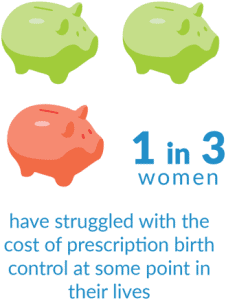Medically reviewed by Sophia Yen, MD, MPH – Written by Pandia Health Editorial Team
What You Need to Know About the Affordable Care Act (aka Obamacare), Birth Control/Contraceptive Coverage

Before Congress passed the Affordable Care Act (ACA), health insurance providers were not required to cover any form of birth control under U.S. law. At the time, insurance coverage for contraceptives varied significantly from one insurance plan to the other. Many women found themselves paying high, out-of-pocket costs for necessary birth control.
The ACA is also known as Obamacare, and it’s important to understand that they are the same thing. Since Congress passed the ACA in 2010, insurers in the US are now required by law to cover at least one form of birth control from each of the 18 FDA-approved contraceptive categories.
What are the eighteen FDA-approved contraceptive categories?
Under the ACA, health insurance plans are legally obligated to cover birth control and counseling without charging co-pays or deductibles if an in-network provider provides the prescription. Even if a patient hasn’t met their deductible, insurers still have to cover the medicine. The different types of birth control products are:
- Hormonal and nonhormonal IUDs.
- Hormonal contraceptives such as the pill, patch, or ring.
- Sterilization.
- Patient counseling related to reproductive issues.
- Barrier methods – sponges, diaphragms, and female condoms. Male condoms are not included.
Insurers are not required to cover medications that induce an abortion, and they are also not required under the ACA to cover vasectomies.
The 18 different types of contraception categories approved by the FDA are:
- The birth control implantable rod.
- The nonhormonal, copper IUD
- The hormonal IUD
- The birth control shot
- The birth control combination pill
- The birth control progestin-only pill
- Extended-use birth control pills
- The birth control patch
- The birth control ring
- Diaphragms
- Cervical caps
- Spermicide
- Sponges
- Female condoms
- Emergency contraceptives Plan B or the morning-after pill
- Emergency contraceptive pill Ella
- Female sterilization surgery.
- The surgical sterilization implant.
Although insurers are required to cover at least one method from each of these categories, insurance plans can still vary and may not include every form of birth control. For example, there are generic and also name-brand birth control products on the market. An insurer can choose to cover only generic types of these methods. Insurers may charge co-pays for non-generic contraceptives. However, under the ACA, if a contraceptive is medically necessary and there is no generic form of it available, the insurer is required to pay for it. The birth control ring is a prime example of this because there is only one type of birth control ring called the Nuvaring which is a name brand product.
Is birth control always “free” under the ACA?
It depends on the specific health insurance plan and what birth control method a woman has been prescribed. Plans may only cover a specific generic for each of the birth control methods, and then the patient may be required to copay for any contraceptive products that are not the ones on their formulary (a formulary is the list of medications the insurance will cover). Women who are covered under Medicaid, employer, or individual or family plans that were sold to them after 2010 can obtain at least one “free” type of birth control from each of the 18 FDA-approved birth control categories. Contraceptives are “free” even if a woman has not met her deductible for the year yet. “Free” equals no co-pay, no deductible.
Are there exemptions for covering birth control under the ACA?
When the ACA was passed, there were lawsuits regarding what employers and their insurance plans were responsible for when it came to contraceptive coverage. Religious employers and non-profit religious organizations raised the most concerns over contraceptive coverage. Since the lawsuits were settled in July of 2015, the following employers and health insurance plans are exempt from covering contraceptives:
- Employers who are religiously affiliated. Houses of worship and churches do not have to provide any contraceptive coverage. Women who are employed by these institutions can obtain birth control coverage through a third party organization.
- Plans that were purchased before March 23, 2010, are grandfathered in and are not required to cover birth control.
- Short-term health insurance plans are also exempt from providing contraceptive coverage.
- Alternative health insurance plans such as health-sharing ministries are exempt from the ACA mandate to provide birth control.
Religious employers, non-profit religious institutions, non-profit hospitals and universities who are religiously affiliated (such as Georgetown and Santa Clara University), and health sharing ministries do not have to provide any contraceptive services, including patient counseling. However, these organizations cannot prevent a woman from obtaining birth control coverage through a third party. Since 2015, women who are employed in these organizations can get “free” birth control through third-party organizations.
What can women do if they work for an employer with a religious exemption?
Women may be able to afford low-cost birth control options out-of-pocket or they may be able to seek low-cost or free birth control options through title X family planning clinics, Planned Parenthood, or a private healthcare clinic. Pandia Health has established the Pandia Health Birth Control Fund to cover birth control medications and annual online doctors visits for those with financial need.
What is the average cost of the most popular birth control methods out-of-pocket?
- Hormonal and nonhormonal IUDs can cost anywhere from $500 to $1000. These birth control methods are 99% effective and can last up to 12 years. The longer a woman uses an IUD, the lower the yearly cost will become.
- Birth control pills cost on average $180 to $600 per year or $15 to $50 per month.
- The birth control patch and ring cost $1800/year or $150/month.
- The average couple spends $150 per year on male condoms.
What can unemployed or low-income women do to obtain affordable birth control?
For women who are unemployed or make below a certain amount of yearly income, they may be eligible for Medicaid. Before the ACA, Medicaid plans were required to cover contraceptives and patient counseling. Medicaid eligibility requirements vary by state. Many private health clinics, Planned Parenthood, and certain pharmacies offer low-cost birth control or financial assistance for contraceptives for women who are uninsured or demonstrate a financial need for help. Pandia Health has established the Pandia Health Birth Control Fund to cover birth control medications and annual online doctors visits for those with financial need.
Are you interested in obtaining free or low-cost birth control? The representatives at Pandia Health are standing by to answer your questions about insurance coverage, name-brand, and generic birth control options. Please contact Pandia Health today to learn if the pill, patch, or birth control ring is right for you.


